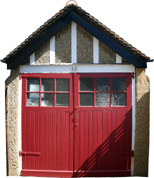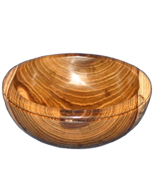Log Cutting Sled Jigs for the Bandsaw.
These jigs are the most useful in the context of
using the Bandsaw as an aid to woodturning when
needing to make an initial straight cut in an
irregular shaped log or in felled timber roughly cut
to shape with a chainsaw.
Although the measurements given here relate to a
particular bandsaw, the design can easily be adapted
to fit most makes and models.
LOG CROSS-CUTTING JIG
It is dangerous to use a bandsaw to cut across a
round log just using your hands to support the stock.
As the blade bites into the log it will exert a
strong forward twisting force which can bruise &
crush your hands and could pull them towards the
moving saw blade. At the same time the blade will be
subject to considerable torque, which will either
cause it to kink or probably snap, rebounding with
considerable force. The jig described below is easy
to make and simple to use as well as being safe.
![[Log Cross-cutting jig - click for larger view] Log Cross-cutting jig.](images/bandsaw-cross-cut-log-sledthmb.jpg)
|
Log Cross-cutting jig for the Record Power
BS300X Bandsaw.
The jig is constructed from 570mm x 292mm x
18mm plywood for the platform, 292mm x 95mm
x18mm plywood for the upstand, 570mm x 25mm
square pine for the guide rail, and two blocks
of softwood measuring 95mm square and 45mm thick
for the reinforcement behind the upstand.
The jig must always be used with a suitable
bar-clamp to secure the wood firmly before commencing to cut.
(Click picture for larger view)
|
![[Log Cross-cutting jig as constructed - click for larger view] Log Cross-cutting jig as constructed.](images/img_2212crannthmb.jpg)
|
Log Cross-cutting jig as constructed.
The jig after construction, ready for use.
(Click picture for larger view)
|
![[Log Cross-cutting jig in use - click for larger view] Log Cross-cutting jig in use.](images/img_2218crannthmb.jpg)
|
Log Cross-cutting jig in use - 1.
The jig in use with an Axminster bar clamp to
cut a small log of Olive wood. The log is held
firmly against the upstand with the barclamp.
Also note how the pine guide rail, abutting
against the edge of the cast iron bandsaw
table, ensures both a straight cut, whilst
protecting the opposite edge of the jig from
accidentally coming in contact with the saw
blade. 23rd March 2016.
(Click picture for larger view)
|
![[Log Cross-cutting jig in use - click for larger view] Log Cross-cutting jig in use.](images/img_2106crthmb.jpg)
|
Log Cross-cutting jig in use - 2.
The jig in use with two Axminster bar
clamps, cutting a large log of Holly.
17th March 2016.
(Click picture for larger view)
|
![[Cross-cut-sled-in-use - click to view movie clip] Cross-cut-sled-in-use](images/movie-02thumb.jpg)
|
Movie clip of the cross-cut sled in use.
Movie clip of the sled being loaded with a
round log of cherry, secured with a bar clamp, and then used with the bandsaw to make a cross-cut.
(Click picture to view movie)
|
LOG LONGITUDINAL CUTTING JIG
My design for this came after browsing many
descriptions of log sleds on several websites, so I
cannot claim it as an original. Although I have
tailored it specifically for use with the Record
Power BS300x Bandsaw, it could be used with any
medium to large workshop bandsaw. Unlike many jigs of
this type, this one operates to the left side of the
saw blade and makes use of the bandsaw fence to
ensure a straight cut. It is particularly useful for
making an initial (or series of) straight slicing
cut(s) along the length of irregularly shaped boles
and boughs of trees up to the maximum depth of cut of
the bandsaw.
It is integrated with an Axminster Trade Bar
Clamp made of zinc plated, cold drawn steel, with
serrated edges to engage securely with the non-slip
mechanism of the sliding arm. Both the fixed and
sliding arms are made of cast iron. The wooden handle
allows for plenty of tightening torque and the
sliding arm (of this particular clamp), gives a
capacity ranging from zero to a maximum length of
just over 400mm, a throat depth up to a maximum
of 100mm, and a maximum clamping pressure of 280kg.
Using the Record Power BS300x Bandsaw, the
clamp, integrated with the wooden jig, can slice logs
up to 200mm (7¾") in diameter, and 360mm
(14¼") in length.
![[Longitudinal-cutting jig for a Bandsaw - click for larger view] Longitudinal-cutting jig for a Bandsaw.](images/project-04a-detailsthmb.jpg)
|
3D-drawing of the Complete Jig.
This interactive Sketchup 3D-drawing, of
the completed jig shows how the
Axminster bar clamp is integrated with
the wooden components. In particular it shows
how the sliding arm of the clamp can be
adjusted on the jig to accommodate varying
lengths of the stock to be sliced.
(Click picture to view the interactive drawing)
|
![[Longitudinal-cutting jig for a Bandsaw - click for larger view] Longitudinal-cutting jig for a Bandsaw.](images/project-04b-detailsthmb.jpg)
|
3D-drawing of the Wooden components of the
jig.
Interactive Sketchup 3D-drawing, of the
completed wooden components (without the bar
clamp) of the jig.
(Click picture to view the interactive drawing)
|
![[Log longitudinal-cutting jig - click for larger view] Log longitudinal-cutting jig.](images/bandsaw-log-sled-explodedthmb.jpg)
|
Log Longitudinal-cutting jig for the Record
Power BS300X Bandsaw.
Exploded view of the jig showing constructional
details.
(Click picture for larger view)
|
![[How the jig integrates with the Bar Clamp - click for larger view] How the jig integrates with the Bar Clamp.](images/img_2227crannthmb.jpg)
|
How the jig integrates with the Bar Clamp.
The Axminster Trade Bar Clamps are made
of zinc plated, cold drawn steel, profiled to
minimise flexing and bending. with serrated
edges to engage securely with the non-slip
mechanism of the sliding arm. Both the fixed
and sliding arms are made of high-grade,
ductile cast iron. The wooden handle allows for
plenty of tightening torque. The clamp used
here has a clamping capacity ranging from zero
to a maximum length of just over 400mm, and a
throat depth up to a maximum of 100mm.
The photograph shows the Axminster bar clamp
(top) with two 5mm holes drilled in the bar to
allow attachment to the jig (shown below),
which has two corresponding M5 machine screws
with wing nuts to hold the clamp in place.
(Click picture for larger view)
|
![[How the jig integrates with the Bar Clamp - click for larger view] Jig set up to cut a log of holly.](images/img_2114crthmb.jpg)
|
Jig set up to cut a log of holly.
17th March 2016.
Photo of the jig in use to cut along a large
log of Holly. Note how the jig abuts on the
left hand side with the fence of the bandsaw,
thereby ensuring a straight cut.
(Click picture for larger view)
|
![[After making a cut - click for larger view] After making a cut.](images/img_2116crthmb.jpg)
|
After making a cut. 17th March
2016.
Using the fence as a guide has ensured a
relatively straight cut.
(Click picture for larger view)
|
![[Preparing to use the jig to cut a crotch of Holm Oak - click for larger view] Preparing to use the jig to cut a crotch of Holm Oak.](images/img_2161crthmb.jpg)
|
Preparing to use the jig to cut a crotch.
21st March 2016.
This jig is particularly useful for preparing
branched wood for the lathe. In this photograph
the jig is being used to cut through a crotch
of Holm Oak.
(Click picture for larger view)
|
![[After making the cut - click for larger view] After making the cut.](images/img_2168rotcrthmb.jpg)
|
After making the cut. 21st March
2016.
The spectacular figured wood of the crotch is
revealed on the cut surfaces.
(Click picture for larger view)
|
Click HERE to return to the Home
Page.
© Tim & Trish Enterprises 2015-2017.


![[Log Cross-cutting jig - click for larger view] Log Cross-cutting jig.](images/bandsaw-cross-cut-log-sledthmb.jpg)
![[Log Cross-cutting jig as constructed - click for larger view] Log Cross-cutting jig as constructed.](images/img_2212crannthmb.jpg)
![[Log Cross-cutting jig in use - click for larger view] Log Cross-cutting jig in use.](images/img_2218crannthmb.jpg)
![[Log Cross-cutting jig in use - click for larger view] Log Cross-cutting jig in use.](images/img_2106crthmb.jpg)
![[Cross-cut-sled-in-use - click to view movie clip] Cross-cut-sled-in-use](images/movie-02thumb.jpg)
![[Longitudinal-cutting jig for a Bandsaw - click for larger view] Longitudinal-cutting jig for a Bandsaw.](images/project-04a-detailsthmb.jpg)
![[Longitudinal-cutting jig for a Bandsaw - click for larger view] Longitudinal-cutting jig for a Bandsaw.](images/project-04b-detailsthmb.jpg)
![[Log longitudinal-cutting jig - click for larger view] Log longitudinal-cutting jig.](images/bandsaw-log-sled-explodedthmb.jpg)
![[How the jig integrates with the Bar Clamp - click for larger view] How the jig integrates with the Bar Clamp.](images/img_2227crannthmb.jpg)
![[How the jig integrates with the Bar Clamp - click for larger view] Jig set up to cut a log of holly.](images/img_2114crthmb.jpg)
![[After making a cut - click for larger view] After making a cut.](images/img_2116crthmb.jpg)
![[Preparing to use the jig to cut a crotch of Holm Oak - click for larger view] Preparing to use the jig to cut a crotch of Holm Oak.](images/img_2161crthmb.jpg)
![[After making the cut - click for larger view] After making the cut.](images/img_2168rotcrthmb.jpg)